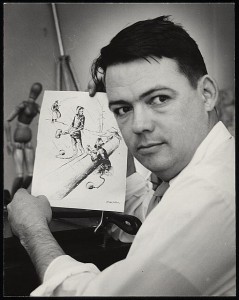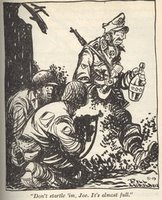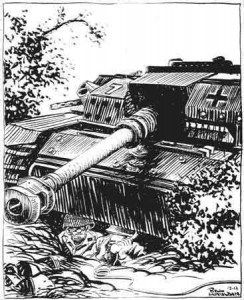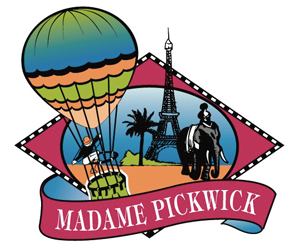Bill Mauldin: Live Art Under Enemy Fire
Bill Mauldin is best remembered as an American cartoonist who at age 23 became the youngest recipient of the Pulitzer Prize for Editorial Cartoon. His talent in the use of inks and charcoal was enhanced by texts and captions in an original and compelling writing style. This visual art appeared to borrow elements from European Expressionism and the writing style was grounded in the American journalistic and short story tradition. Mauldin is credited with teaching us to understand war in a way like no one before him through the medium of the illustrated cartoon. He lived from 1921 to 2003 and won a second Pulitzer in 1959.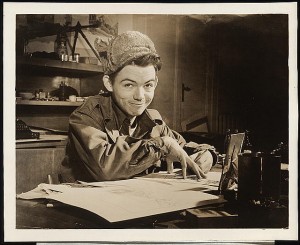
Mauldin’s popularity was based on his cartoons during WW2 while serving as sergeant in the US army’s 45th Infantry Division. His notoriety was based on documenting the adventures and misadventures of army ”dogfaces” Willie and Joe , Mauldin’s creations to represent symbols of the infantry. Mauldin, would draw on the front-lines under the shelling and artillery fire of the enemy. It is as if illustration acted as a distraction for Mauldin to prevent his own sanity from escaping him under the combat pressure.
( Bombs and rockets detonate overheard punctuated by small arms fire)
Mauldin: Leave me alone darn ordnance. I’m in the zone drawing.
Willie: Put dat pencil dan and pik up yer rifle
Joe: Damm bombs. I feel like a fugitive from the law of averages
Mauldin : I’ll trade you a butt for a scrap of paper to draw on…
Joe: Daing the’s dam Goimans!
Willie: Don’t mention it lootenant. they mighta replaced ya wit’ one of them salutin’ demons
Mauldin: I’m a born troublemaker and might as well earn a living at it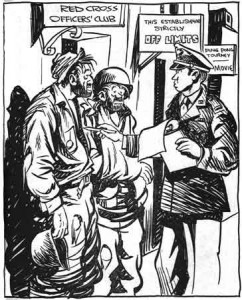
Mauldin’s vision was to de-mythologize war and express the essentials of our existence in clear, logical and concise terms. He had gifted ability to draw, paired with the perspective necessary to seek the truth within a humoristic idiom. Mauldin portrayed misery without despondency, fear without cowardice, all in a narrative that was endearing and personal. He created his own writing style by employing the argot of the soldier in an ironic and biting fashion, to touch upon complex issues and common frustrations. It was form of anti-propaganda meant to be appreciated by the war’s actual participants.”Up Front” was a compendium of his war work which sold over three million copies in hardcover within two years after publication in 1945. Up Front was 18 months as number one on the New York Times bestseller list. The book was a random yet coherent collection of thoughts on the death and maiming of youth and the structures of power and control exercised over the lowly foot soldier. Yet, the artistic expression is irreverent and hopeful, imbued with a sense of something indestructable in the human spirit while confronting life’s absurdities and shadowlands. The fading innocence of a still unique American spirit served as background to his artistic portrayals.
Mauldin portrayed the theater of war as a living, direct truth in a fashion not previously seen. He was an artist of great personal integrity and was profoundly opposed to the racism and economic injustices he saw. His soul seemed connected to an enduring sensibility that was pure and whole. He usually worked deep into the night re-working and refining drawings made in the trenches with combat troops. This was his way of capturing a realism and vibrant energy. The humour is deliberately heavy. Almost black humour. The world is a demi-monde that hints of Kafka and Erich Maria Remarque’s ”All Quiet On The Western Front”, yet avoids fatalism, pathos and an inevitable tragic climax.
The drawing approach, novel at the time among Americans, consisted of creating atmosphere with a style of flashing blacks and heavy lines complemented with fine strokework.The technique was ink over pencil and the use of white-out which created his ”weathered” look signature style. The ink sometimes appears applied using techniques from watercolor. The style seems to draw on European lithographs, woodcuts, popular illustration and political cartoons such as found in Weimar Germany. Mauldin did have a formal arts education at the Chicago Academy of Fine Arts under Ruth Van Sickle Ford herself the child of German and Dutch parents. Ford also taught cartoonist Walt Disney.
”It was as if he ( Mauldin ) was drawing out of the mud that the infantrymen travelled on. And I mean, they looked like they were just curdling on the paper these lines. And that was part of the power, that one felt Maudlin’s weather in the cartoons. It was winter…” (Jules Feiffer)
Mauldin was an excellent writer and could have also excelled in novels and short stories. After WW2 he changed his drawing style to a less assertive tone while the texts became more radical. Had Mauldin continued his style but applied different concepts he was exploring through the structure he had created, this may have led a very sophisticated an advanced oeuvre, pushing the medium into the realm of a more powerful artistic expression. The following is an excellent study of Mauldin in the first half of the video post:
This second video post is a terrific tribute to Mauldin and the context in which he created. The jeep (Willy’s) is a prominent fixture in Mauldin’s work as it represents a value of liberty analogous to the horse in the American west:
